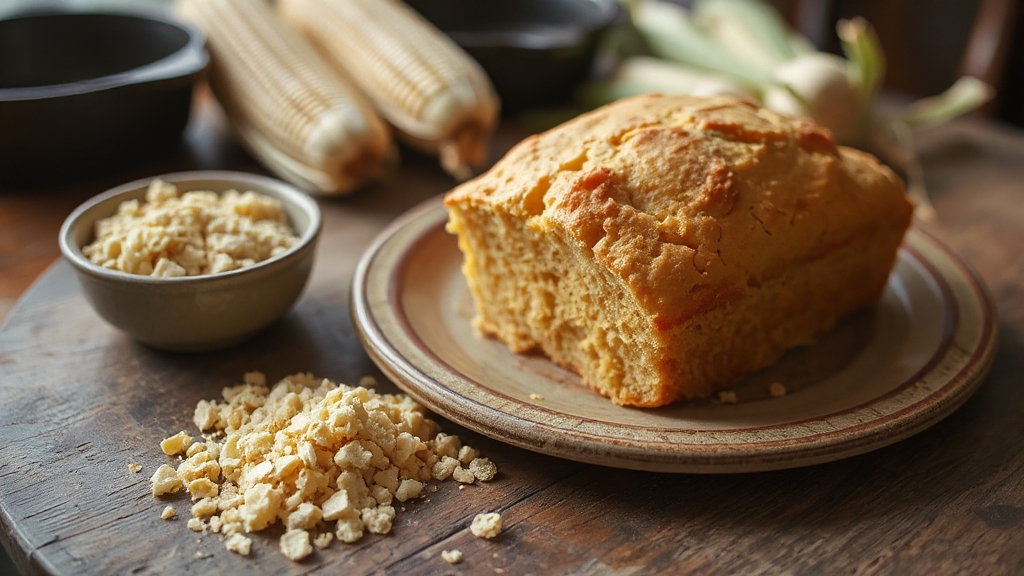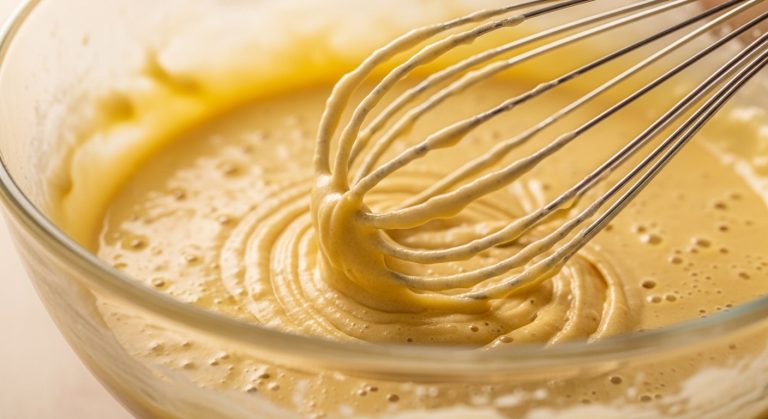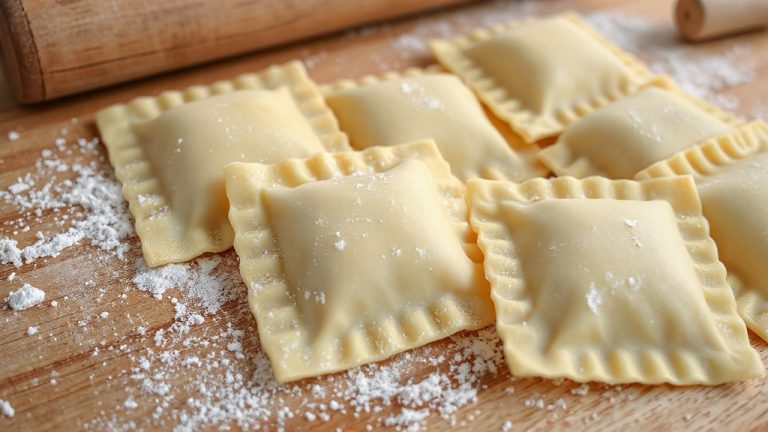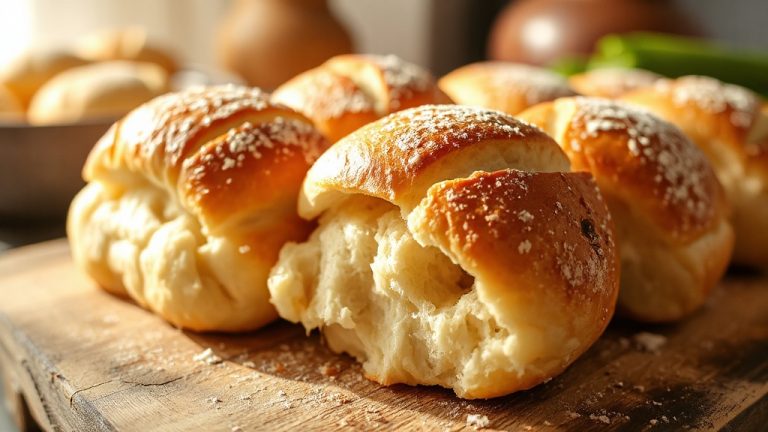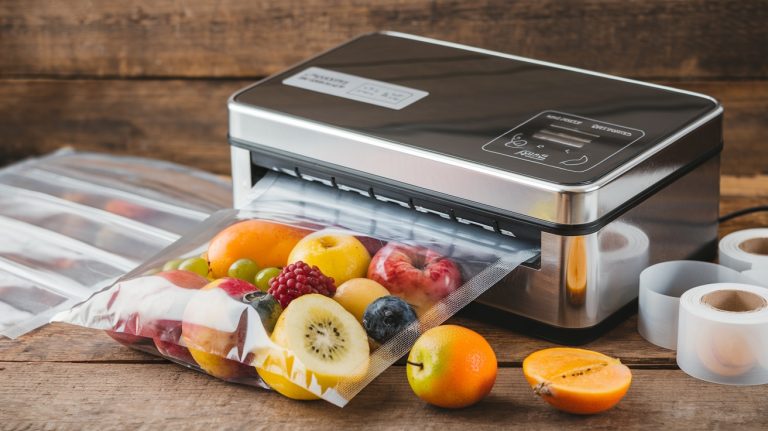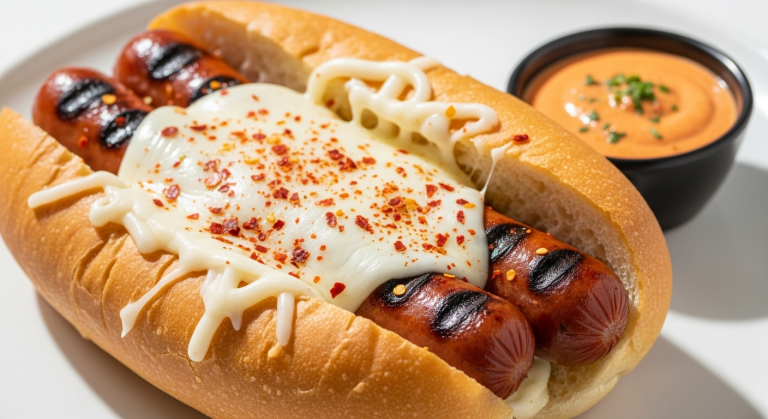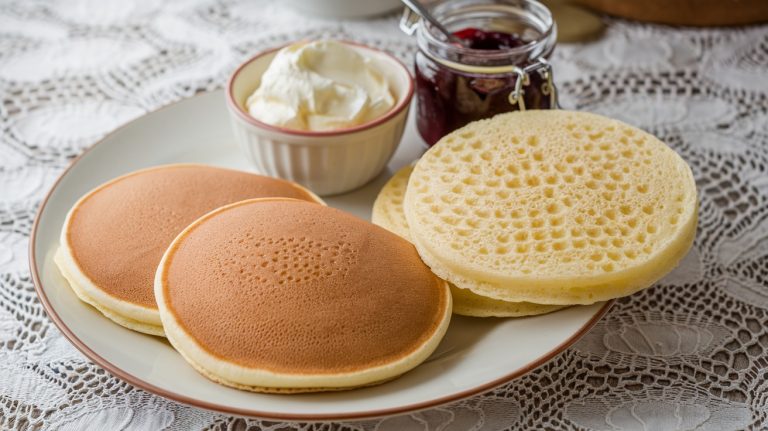Can You Make Cornbread With Grits: A Hearty Southern Twist
You can make cornbread with grits, which gives your bread a heartier texture and earthier flavor than traditional cornmeal. Because grits are coarser and absorb more liquid, you’ll want to soak or par-cook them for a tender crumb and adjust the batter’s moisture.
Using a hot cast iron skillet helps create a crispy crust that contrasts perfectly with the chewy interior. Keep experimenting, and you’ll uncover tips to master this rustic, tasty twist.
Key Takeaways
- Yes, you can make cornbread with grits, using a 1:1 weight ratio substitution for cornmeal, but expect a coarser texture.
- Soaking or par-cooking grits before baking prevents gritiness and results in a softer, more enjoyable crumb.
- Using a preheated cast iron skillet helps develop a crispy, golden crust that complements the hearty grit texture.
- Combining grits with flour or finer cornmeal balances texture and improves batter consistency for tender cornbread.
- Adjust liquid amounts and baking times to account for grits’ higher moisture absorption and denser grain.
Grits Cornbread Recipe
| Ingredients | Process |
|---|---|
| 1 cup grits | Soak in 1 cup hot water for 30 minutes, then drain |
| 1 cup all-purpose flour | Whisk together with sugar, baking powder, and salt in large bowl |
| 1/4 cup sugar | Mix with dry ingredients |
| 2 teaspoons baking powder | Combine with flour mixture |
| 1 teaspoon salt | Add to dry ingredients |
| 1 1/4 cups buttermilk | Whisk together with eggs and melted butter |
| 2 large eggs | Beat with buttermilk mixture |
| 1/3 cup melted butter | Combine with wet ingredients |
| Additional butter for pan | Grease cast iron skillet and place in oven while preheating |
The Difference Between Grits and Cornmeal
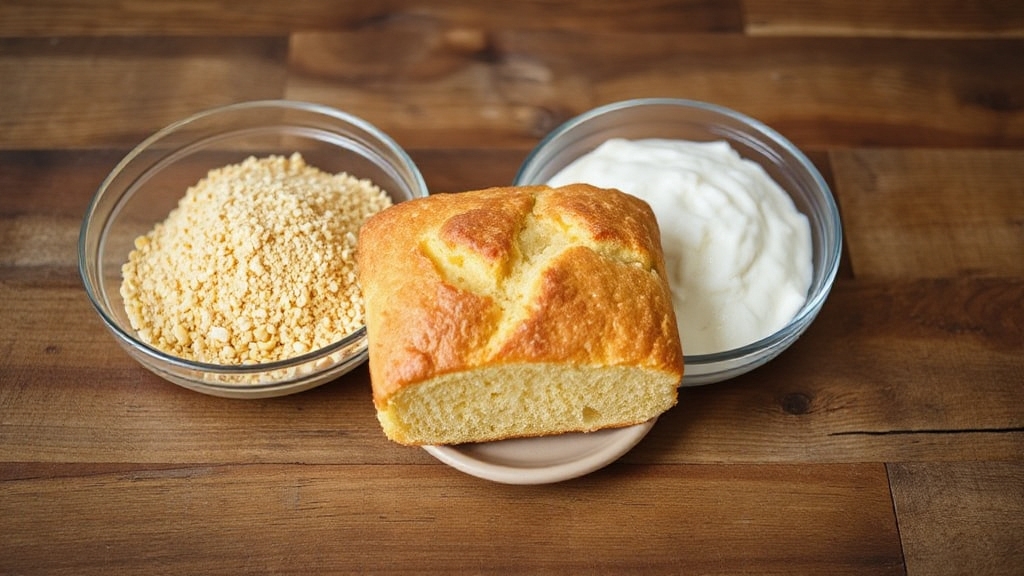
What sets grits apart from cornmeal? You’ll notice it’s mainly the grind and treatment of the corn. Both come from dried dent corn, but grits are coarser, often made from hominy—corn treated with lime to remove the hull. This nixtamalization changes their flavor and texture, making grits grainy and chewy when cooked.
Grits are usually made from dent corn, which contains soft starch that gives them a smooth, creamy texture when cooked soft starch. Anise oils with a strong and concentrated flavor are often used to enhance the taste of baked goods made with cornmeal, providing a distinct aromatic boost that grits typically do not require.
Cornmeal, on the other hand, is usually finely ground, giving it a powdery texture perfect for baking. While cornmeal preserves a slightly sweet, natural corn flavor, grits have a creamier, more neutral taste due to processing. Using super-strength anise oils in recipes involving cornmeal can elevate the overall flavor profile, especially in cornbread and muffins.
Understanding these differences helps you see why each suits different dishes, with grits favored for porridge and cornmeal for baked goods like cornbread and muffins.
How Grits Affect the Texture and Flavor of Cornbread?
Having explored how grits differ from cornmeal, it’s clear these differences shape the texture and flavor of your cornbread in distinct ways. Grits, with their coarser grain, add a pleasantly chewy, hearty crunch to your cornbread crumb, creating a rustic mouthfeel that stands out from the smoother, finer cornmeal versions.
Their less processed nature preserves a fuller, earthier corn flavor, lending your bread a wholesome, savory depth. However, if you skip soaking or par-cooking, you might notice an unpleasant gritty texture. Proper hydration softens grits, balancing chewiness and tenderness.
Corn Grits can be used alone as a substitute for cornmeal in cornbread, but adjustments might be necessary to ensure proper consistency. Expect a denser crumb and a less sweet, more robust corn taste.
Embracing grits transforms your cornbread into a textured, flavorful experience that pairs well with savory dishes. To maintain the best texture and freshness, consider proper moisture control during storage to prevent staleness and preserve the bread’s quality.
Substitution Ratios for Using Grits Instead of Cornmeal
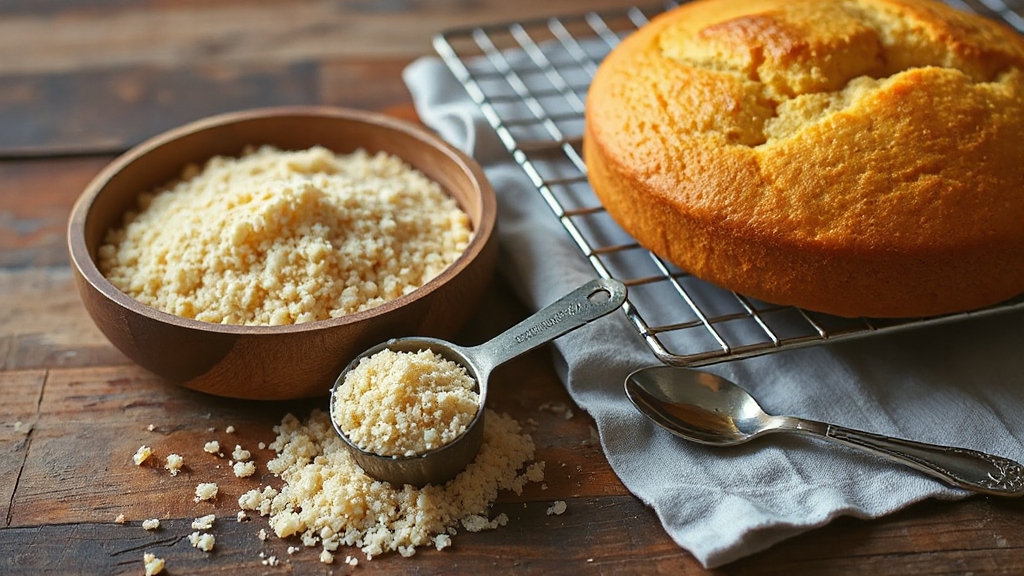
You can substitute grits for cornmeal in your cornbread recipe using a one-to-one weight ratio, but keep in mind the texture will be coarser. Grits are a coarse and gritty ground corn product that can provide a similar texture to cornmeal.
To get a smoother crumb, try combining grits with finer corn flour or grinding them more finely before baking. Adjusting the liquid content can also help balance the batter since grits absorb moisture differently than cornmeal.
Because both grits and cornmeal are naturally gluten-free, this substitution maintains a gluten-free option for those with dietary restrictions. For storing and reheating cornbread made with grits, using airtight containers can help preserve freshness and texture.
One-to-One Weight Ratio
A reliable rule for substituting grits for cornmeal in cornbread recipes is to use an equal weight ratio—one-to-one by weight. This guarantees the mass and absorption properties stay balanced, despite grits being coarier than cornmeal.
To get it right:
- Weigh your grits and cornmeal instead of relying on volume measurements.
- Use a kitchen scale to measure both ingredients precisely.
- Replace cornmeal with an equal weight of grits for consistent results. Keep in mind that grits will impart a gritty crumb which may be desirable or not depending on your preference.
- Keep other dry ingredients unchanged; adjust liquids only if needed after batter consistency checks.
Texture Adjustment
When substituting grits for cornmeal in cornbread, adjusting the texture is key to achieving a pleasing crumb and mouthfeel. Start by soaking your grits for at least 30 minutes or even overnight in buttermilk to soften them and reduce grit.
Because grits are typically ground coarser than cornmeal, they require longer cooking times to become tender stone-ground grits. You can also par-cook the grits to ensure they fully soften during baking, which prevents a dense or raw texture.
Since grits absorb more moisture, increase your liquid content slightly with water or buttermilk to keep the batter creamy and the crumb tender. Using a wide mixing bowl can help you combine ingredients thoroughly and accommodate the expanded batter volume.
Keep in mind that baking time might need extending to cook grits thoroughly without drying out the bread. For a smoother texture, consider grinding your grits finer before use. These tweaks will help you create a cornbread that’s moist, flavorful, and delightfully textured.
Combining Grits and Flour
Although grits can replace cornmeal on a one-to-one basis in most cornbread recipes, combining them with flour often yields a better texture and structure.
When you mix grits with all-purpose or wheat flour, you get a balanced crumb and improved rise. Here’s how to optimize your substitution:
- Use equal parts grits and flour (e.g., ½ cup each) to maintain batter balance. This ratio helps mimic the artisan bread texture sought by sourdough enthusiasts.
- Soak grits in milk or buttermilk for at least 30 minutes to soften their coarseness. This soaking process also helps the grits absorb liquids better, improving the final texture Liquid absorption varies.
- Adjust liquids slightly if using whole wheat or oat flour, as they absorb more moisture.
- Increase leavening agents like baking powder to counteract grits’ coarser texture and enhance fluffiness.
Tips for Preparing the Batter
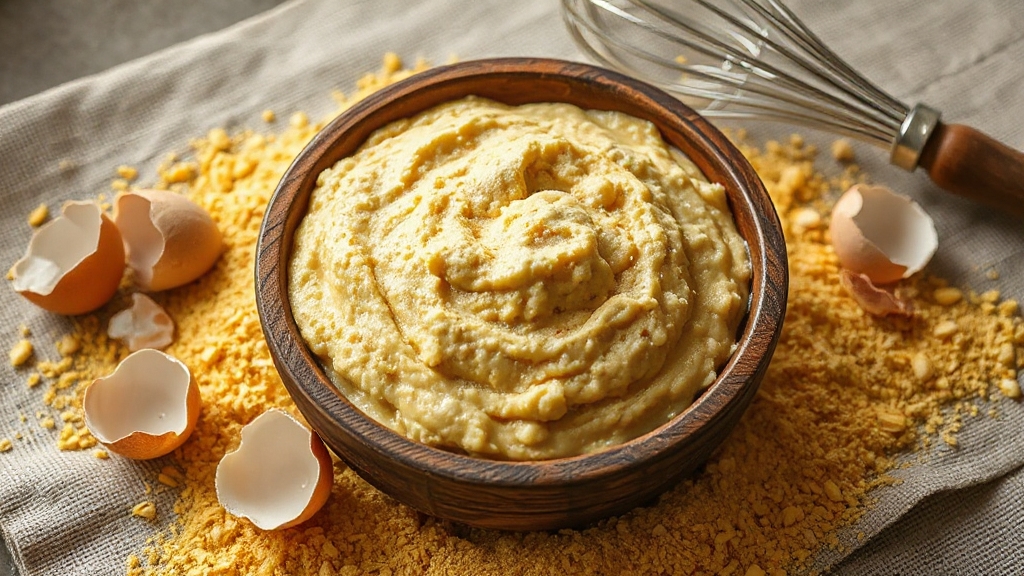
Since grits absorb more moisture than regular cornmeal, you’ll want to soak them beforehand and adjust your liquid ratios carefully to avoid dry or dense cornbread. Soak grits in hot water for 30 minutes or in buttermilk overnight for enhanced softness and flavor.
Mix dry ingredients thoroughly before folding in the whisked wet mix gently to keep the batter tender. Adding melted butter enriches the taste and texture, and resting the batter allows moisture to distribute evenly. Using measurement markings can help ensure precise liquid adjustments for the perfect batter consistency.
| Preparation Step | Tip |
|---|---|
| Soaking | Use hot water (30 min) or buttermilk (overnight) |
| Liquid Adjustment | Increase buttermilk or water for moisture |
| Mixing | Combine dry well; fold wet in gently |
| Batter Resting | Let batter rest briefly for even texture |
Baking Techniques Ideal for Grits Cornbread
To get the best texture, let your grits cornbread batter rest briefly before baking, allowing flavors to meld and hydration to improve. Preheat your oven to around 425°F and use a hot cast-iron skillet to achieve a crispy crust and even cooking.
Using a preheated cast iron skillet mimics professional baking techniques by providing superior heat retention and distribution. Signing in is required to ask questions about the recipe, which can help clarify baking techniques and improve results. These steps help you capture the perfect rise and develop that classic, golden-brown finish.
Batter Resting Benefits
How long you let your grits cornbread batter rest can make a big difference in texture and flavor. Resting allows the grits to fully hydrate, softening their texture and preventing gritiness in the final cornbread. It also helps the batter develop better structure and height when baked. Here’s why you should consider resting your batter:
- Hydrated grits blend smoothly with other ingredients, creating a tender, moist crumb.
- Resting thickens the batter slightly, improving rise and crumb stability.
- Flavor complexity deepens, as buttermilk and grits interact, mellowing raw corn notes.
- Proper rest balances moisture, preventing dense or dry textures in your cornbread. This process is enhanced when using baking methods that provide even heat distribution.
- Using whole-grain or stone-ground grits in your batter enhances the nutritional value and adds a hearty texture that benefits from resting.
Optimal Oven Temperatures
Letting your batter rest sets the stage for baking success, but controlling oven temperature truly shapes the final cornbread’s texture and flavor.
Aim to preheat your oven between 400°F and 425°F. At 425°F, you’ll get a beautifully browned, crispy crust, especially if you pour batter into a hot, greased pan. If you prefer a softer crumb with moderate browning, 400°F works well. Using a baking thermometer ensures you maintain precise temperature readings for consistent results.
Baking times vary from 20 to 30 minutes, so keep an eye on the golden crust pulling away from the pan’s edges and test doneness with a clean toothpick. Using a cast iron skillet helps achieve the ideal crispy bottom and moist interior.
Maintaining a consistent temperature guarantees the grits cook evenly, avoiding gritiness while balancing moistness inside and crispness outside for that perfect slice. A thermometer with a fast response time can help you monitor oven heat and avoid over- or under-cooking.
Cast Iron Usage
When you use a cast iron skillet for grits cornbread, you open a whole new level of texture and flavor that other pans just can’t match. The even heat distribution guarantees a crispy, golden crust while keeping the inside moist. Seasoned cast iron adds subtle depth, enhancing every bite.
To nail your baking:
- Preheat your skillet in the oven for 5–7 minutes, then add a generous layer of fat like bacon grease or melted butter.
- Pour batter immediately to hear that satisfying sizzle, which locks in crispiness.
- Bake at 375°F to 450°F for about 20–25 minutes until set and golden.
- Let cornbread rest in the skillet for 10 minutes before removing to avoid sticking.
Using a thermometer to monitor oven temperature ensures consistent results and prevents over- or under-baking, which is crucial for achieving the perfect texture in grits cornbread oven temperature monitoring.
Flavor Enhancements and Ingredient Additions
Although grits cornbread has a naturally comforting base, you can elevate its flavor by incorporating a variety of savory, sweet, and spicy ingredients. Try scallions or cheddar for savory depth, or add blueberries and cinnamon for sweetness.
Spice lovers can mix in cayenne or jalapeños to awaken the palate. Texture-wise, soaked grits or a touch of masa harina boost moisture and complexity.
Using the proper size options for your baking pans can help ensure even cooking and a perfect crust. When selecting grits, consider using stoneground varieties as they retain more nutrients and offer a heartier texture that enhances the overall cornbread experience with whole grain goodness.
| Flavor Category | Ingredient Examples | Effect on Cornbread |
|---|---|---|
| Savory | Cheddar, bacon, scallions | Adds richness, umami, and freshness |
| Sweet | Brown sugar, blueberries | Balances savory notes, adds bursts |
| Spicy | Cayenne, jalapeños | Introduces heat and smoky undertones |
| Texture | Soaked grits, masa harina | Enhances moisture and adds crunch |
Nutritional Benefits of Using Grits in Cornbread
Because grits bring a unique nutritional profile to your cornbread, incorporating them can boost both flavor and health benefits. When you add grits, you’re not just changing texture—you’re enhancing nutrition considerably. Here’s what grits contribute:
Adding grits to cornbread enriches flavor and significantly boosts its nutritional value.
- Energy and Fiber: Grits provide moderate calories and fiber, supporting digestion and steady energy release.
- Protein Boost: With 3-4 grams of protein per serving, they help keep you full and aid muscle repair.
- Rich Micronutrients: Expect iron, B vitamins, magnesium, and zinc, essential for metabolism and bone health.
- Heart-Healthy and Gluten-Free: Low in fat and naturally gluten-free, grits make cornbread lighter and accessible for many diets. Additionally, choosing stone-ground grits can enhance nutrient retention due to less processing, preserving beneficial plant compounds.
Troubleshooting Common Issues When Baking With Grits
If you want your cornbread with grits to turn out just right, you’ll need to tackle a few common baking challenges head-on. First, par-cook your grits or use finer ground grits to avoid a gritty, undercooked texture. Using a cast iron pan can help achieve a crispy crust that enhances the flavor and texture.
Add extra liquid since grits absorb more moisture than cornmeal, preventing dryness. Avoid overmixing the batter to keep your cornbread tender and light. Preheat your cast iron skillet to develop a golden, crisp crust that adds flavor and texture.
If your batter is too runny or too dense, adjust the flour-to-grit ratio and monitor oven temperature closely. Docking the batter can prevent cracking. Experiment with these tweaks, and you’ll master moist, flavorful cornbread with the unique character grits bring.
Frequently Asked Questions
Can Grits-Based Cornbread Be Frozen and Reheated Successfully?
You can freeze grits-based cornbread successfully by wrapping it tightly in foil or plastic wrap and cooling it completely first. Slice it beforehand for easy reheating.
When ready, thaw it overnight in the fridge, then warm it in a 350°F oven wrapped in foil. This method keeps it moist and preserves texture.
Avoid microwaving to prevent dryness, and consider adding a splash of milk when reheating to restore creaminess.
Are Instant Grits Suitable for Making Cornbread?
You might be surprised, but instant grits can work well for cornbread! Their fine texture means your bread will be smoother and less crumbly, with a milder flavor than traditional cornmeal.
You’ll want to tweak liquid amounts and maybe soak the grits briefly to keep moisture just right.
Instant grits speed up prep and baking, making them a convenient, practical choice—just expect a softer, less crunchy cornbread experience.
How Does the Type of Corn Used in Grits Affect Cornbread Taste?
The type of corn in grits shapes your cornbread’s flavor big time. Yellow corn grits bring a sweeter, fuller corn taste, while white corn offers a milder, subtler profile.
If you use nixtamalized hominy-based grits, expect a tangy, deeper corn essence.
Plus, stone-ground grits add a nutty richness that instant grits lack.
Can Gluten-Free Grits Cornbread Be Made Without Additional Flour?
You can’t have your cake and eat it too without some extra help when making gluten-free grits cornbread without additional flour. Grits alone tend to create dense, crumbly bread, so you’ll need binders like eggs or applesauce and leavening agents such as baking powder to get a lighter texture.
Pre-soaking grits and adding moisture-rich ingredients like cream-style corn will also help you achieve a tender, flavorful loaf.
What Are the Best Beverage Pairings for Grits Cornbread?
You’ll find that cold milk or tangy buttermilk perfectly balance grits cornbread’s buttery richness.
For a cozy touch, sip on black coffee or spiced chai tea, which highlight the bread’s warmth and sweetness.
If you prefer something lighter, try a crisp pilsner or a dry white wine to cut through the richness.
Non-dairy milks like almond or oat provide creamy, nutty flavors, while kombucha adds an invigorating tangy contrast.
Bake Boldly—Grits Turn Up the Flavor Volume
Think of using grits in cornbread like swapping a classic guitar for a banjo—both stringed, but each brings a unique twang. When you replace cornmeal with grits, your cornbread gains a heartier, creamier texture that dances on your tongue differently.
Just like a banjo adds a fresh rhythm to a familiar tune, grits transform traditional cornbread, making each bite a new experience you’ll want to play again and again.

